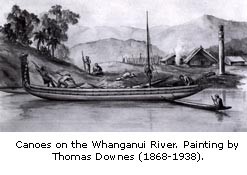Treaty of Waitangi past and present: Aotearoa the way it was
Section 1: Aotearoa the Way it Was
For hundreds of years before the Pakeha arrived, Māori lived in all parts of our country. Life was hard, but the land, bush, rivers, lakes, and oceans provided food and resources for the people.
Home, Kainga

The kainga was where the fires burned. The land, whenua, was protected. Rivers, forests, and hills were all important places. They provided shelter and food and were given special names. The names were a way of recording history. They would remind people about ancestors or events from many years ago. The land was not owned by a single person. It had to be shared among the many relatives. People had to respect the land and respect each other.
Whānau (extended families) would often combine and build a kainga. Suitable land for cultivations and food gathering would usually be nearby. However, children and their whānau did not live in one kainga all year round. Whānau would move around to harvest birds, catch fish, or gather seafood. Kainga would almost always have a whare puni – a meeting house used to welcome people or hold a hui.
A Māori woman, Makereti, born in Rotorua in 1872, wrote a book about how the old-time Māori lived before the arrival of the Pakeha. She described what it was like to live in a kainga:
No outsider would come and settle in a kainga, he would only come as a guest. Each family group had its own piece of ground which would be fenced off, and within this they would have their houses, two, three or more. These houses would be used for sleeping … A family group would also have a wharau or kauta built close by, to use for cooking in the bad weather. In good weather, they would cook outside. They had special buildings and pits for storing food.
Laws, Rules, and Behaviour
Māori had a system of laws and rules in the same way that we have a system of laws and rules today. Everybody knew what those laws and rules were, and that they would probably be punished if they misbehaved. Special people called tohunga knew a lot about the rules. They spent many years training and were very clever people.
Children (tamariki) were treasured by all the whānau. Grandparents helped care for children. It was important for children to learn the value of cooperation at an early age. Makereti said that children had to share in the work and do things such as fetch water. Children had to learn about hunting, gathering food, making their clothes, and recognising plants and animals. This was as valuable as school work is today.
At night, children would hear stories from their parents and grandparents. This taught them about the history of their whanau and hapu. There were no books or writing. Instead, songs and stories were important. Carving was also a vital way of passing on history. Many carvings would be given special names and many of them contained significant messages. They were passed on from one generation to another.
Trading
Māori were business people. They had a very good system of trading. Hapu would trade with each other. Often pigeons and other birds would be traded for seafood. Feather cloaks were traded for weapons. In some cases, canoes were traded. When kumara and other goods were traded, they would be transported by waka. One of the most famous things that was traded was pounamu, the beautiful greenstone from the South Island. It was wanted by all the hapu because it was good for making weapons, ornaments, and jewellery. It was carried over the mountains and taken on canoes to kainga hundreds of miles away from the South Island.
Next: Questions and Activities
This page was last updated: